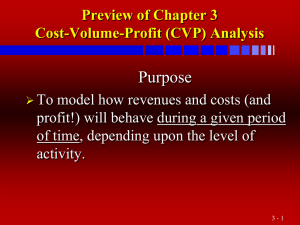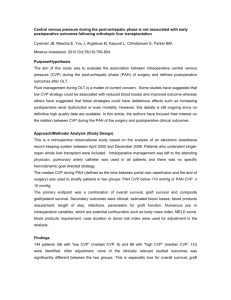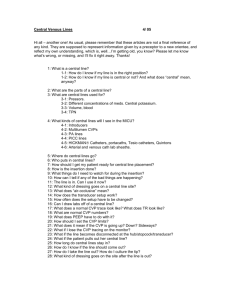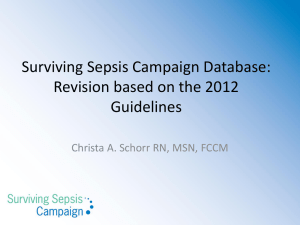Document 5594769
advertisement
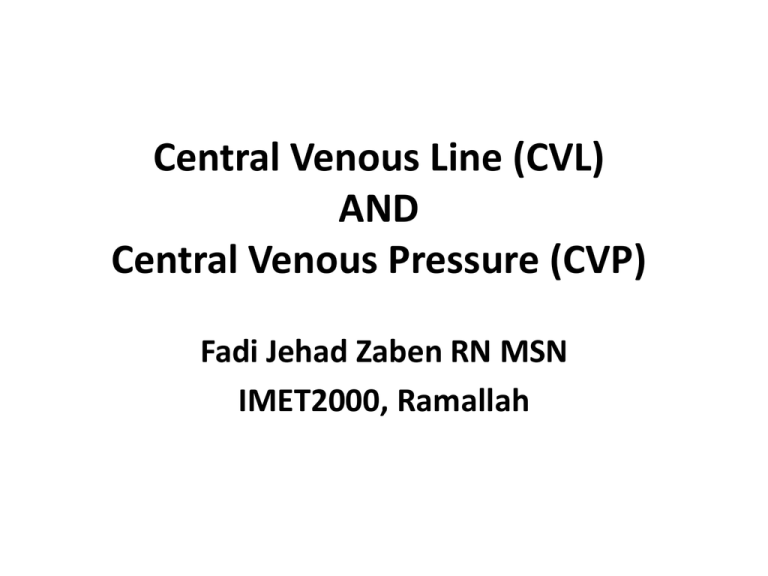
Central Venous Line (CVL) AND Central Venous Pressure (CVP) Fadi Jehad Zaben RN MSN IMET2000, Ramallah Learning Outcomes: • Describe the sites of central venous catheterization. • Understand why central venous pressure monitoring is performed. • Demonstrate how to perform central venous pressure monitoring using a manometer and a transducer. • State normal parameters for CVP. Introduction: • The central venous pressure reflects the right atrial pressure (RAP) and is similar to measuring the JVP clinically. • Central venous pressure measurement is often associated with intensive and critical care settings. • Circulating blood flows into the right atrium via the inferior and superior vena cava. The pressure in the right atrium is known as central venous pressure (CVP). • Critically ill unstable patients may need hourly measurements of CVP. TYPES OF CENTRAL LINE: • • • • • SINGLE LUMEN DOUBLE LUMEN TRIPLE LUMEN QUADRUPLE LUMEN QUINTUPLE LUMEN Single, Double, and Triple Lumen Central Lines Indications Central Venus Line (CVL): 1. Need for IV access and failure of peripheral access 2. Peripheral access too painful or very difficult 3. Long term IV access anticipated 4. Infusion of drugs which may cause peripheral problems e.g. vasoconstriction, phlebitis 5. Hemodynamic monitoring 6. Volume resuscitation with large bore central lines 7. CVP measurement, Rt atrial pressure 8. To obtain frequent blood sample 9. To determine how much fluid is needed in 24 hr 10.Insertion of a pacing wire. Relative Contraindications: 1. Bleeding disorders (platelet counts <50,000, bleeding is uncommon and easily managed). 2. Anticoagulation or thrombolytic therapy. 3. Combative patients. 4. Distorted local anatomy. 5. Cellulitis, burns, severe dermatitis at site. 6. Vasculitis. Sites for insertion of CVL: • • • • Internal jugular. Subclavian. Femoral vein. Brachial vein for long lines. Factors Affecting the CVP: Systemic vasodilatation and hypovolaemia, which leads to reduced venous return in the vena cava and reduced RAP Right ventricular dysfunction and pulmonary hypertension leads to raise right atrial pressure, as does tricuspid and pulmonary stenosis. Advantages Versus Disadvantages Of Sites for insertion of CVL: Continue…… Normal CVP Measurements: • The normal CVP is between 5 – 10 cm of H2O or (2-5) mmHg. • It increases 3 – 5 cm H2O when patient is being ventilated. Increase of CVP: • CVP increased in the following conditions: Over hydration. Right-sided heart failure. Cardiac tamponade. Constrictive pericarditis. Pulmonary hypertension. Tricuspid stenosis and regurgitation. Stroke volume is high. CVP reading is High: Decrease of CVP: Hypovolemia. Decreased venous return. Excessive veno or vasodilation. Shock. If the measure is less than 5 cm water that mean that the circulating volume is decrease. CVP reading is Low? CVL Insertion: 1) 2) 3) 4) Equipment. Patient position. Procedure. After insertion. Equipment: 1. 2. 3. 4. 5. 6. 7. Sterile gloves, gown, suture pack. Iodine solution. 10 ml syringe, 2% lidocaine, 10 ml N.S. Catheter special size. H2O manometer. Flush solution with complete CVP line. Dressing set. Catheterization Kits Patient Position: Patient is moved to the side of the bed so physician would not lean over. The bed is high enough so physician would not have to stoop over. Patient should be flat without a pillow, Trendelenburg position if patient is hypovolemic. The head is turned away from the side of the procedure. Wrist restraints if necessary. Procedure: Skin preparation: • Prepare before putting sterile gloves • Allow time for the sterilizing agent to dry Drape: • Large enough and Handed sterilely by the assistant. • Hole in the area of placement. Prepare the tray: • Prepare the equipment before starting. Anesthesia: • Use local anesthesia with lidocaine. Nursing Role After CVL Insertion: • • • • • • • • • Dispose all sharps. Place an occlusive sterile dressing. Flush lumens to maintain patency. Obtain a chest x-ray (ask for order if physician doesn’t mention it). Monitor site for bleeding. Assess breath sounds. Assess circulation. Assess for hematoma. Document insertion, site, dressing and flushing. Chest X-ray and CVL USING THE CENTRAL LINE: • • • • • Flush q shift, before and after use with NS. Some places also require heparin flush. Close clamps when not is use. Dressing is usually changed every days. Line can be used for blood drawing –withdraw and waste 10 cc, then withdraw blood for samples. • If port becomes clotted, do not use – sometimes ports can be opened up. Immediately Complications of Insertion CVL: 1. Hemothorax. 2. Pneumothorax (most common). 3. Bleeding: More common in patients with coagulopathy“easily control femoral”. 4. Arterial puncture. 5. Vessel erosion: Large vessel perforation “Dialysis”. 6. Nerve Injury. 7. Dysrhythmias. 8. Catheter malplacement. 9. Embolus. 10.Cardiac tamponade. Delayed Complications: 1. 2. 3. 4. 5. 6. 7. Dysrhythmias Infection “Late, Femoral > IJ > subclavian” Catheter malplacement. Vessel erosion. Embolus. Cardiac tamponade. Thrombosis. Measuring CVP: There are two methods of CVP monitoring: • Manometer system: enables intermittent readings and is less accurate than the transducer system • Transducer system: enables continuous readings which are displayed on a monitor. CVP System: Phlebostatic Axis: • 4th intercostal space, mid-axillary line • Level of the atria CVP Measurement: 1. Line up the manometer arm with the phlebostaticaxis ensuring that the bubble is between the two lines of the spirit level. 2. Move the manometer scale up and down to allow the bubble to be aligned with zero on the scale. This is referred to as 'zeroing the manometer'. 3. Turn the three-way tap off to the patient and open to the manometer. Continue……. 4. Open the IV fluid bag and slowly fill the manometer to a level higher than the expected CVP. 5. Turn off the flow from the fluid bag and open the three-way tap from the manometer to the patient. 6. The fluid level inside the manometer should fall until gravity equals the pressure in the central veins. Continue……. 7. When the fluid stops falling the CVP measurement can be read. If the fluid moves with the patient's breathing, read the measurement from the lower number. 8. Turn the tap off to the manometer. 9. Document the measurement and report any changes or abnormalities. Using a Transducer: • Explain the procedure to the patient to gain informed consent. • The CVC will be attached to intravenous fluid within a pressure bag. • Ensure that the pressure bag is inflated up to 300mmHg. • Place the patient flat in a supine position if possible. Alternatively, measurements can be taken with the patient in a semi-recumbent position. • The position should remain the same for each measurement taken to ensure an accurate comparable result. Continue……. • Catheters differ between manufacturers, however, the white or proximal lumen is suitable for measuring CVP. • Tape the transducer to the phlebostaticaxis or as near to the right atrium as possible. • Turn the tap off to the patient and open to the air by removing the cap from the three-way port opening the system to the atmosphere. Continue……. • Press the zero button on the monitor and wait while calibration occurs. • When 'zeroed' is displayed on the monitor, replace the cap on the threeway tap and turn the tap on to the patient. • Observe the CVP trace on the monitor. The waveform undulates as the right atrium contracts and relaxes, emptying and filling with blood. • Document the measurement and report any changes or abnormalities. CENTRAL VENOUS PRESSURE THE CVP WAVEFORM: The CVP waveform reflects changes in right atrial pressure during the cardiac cycle REMOVAL OF CENTRAL LINE: • This is an aseptic procedure. • The patient should be supine with head tilted down. • Ensure no drugs are attached and running via the central line. • Remove dressing. • Cut the stitches. • If there is resistant then call for assistance. • Apply digital pressure with gauze until bleeding stops. • Dress with gauze and clear dressing. THE END
